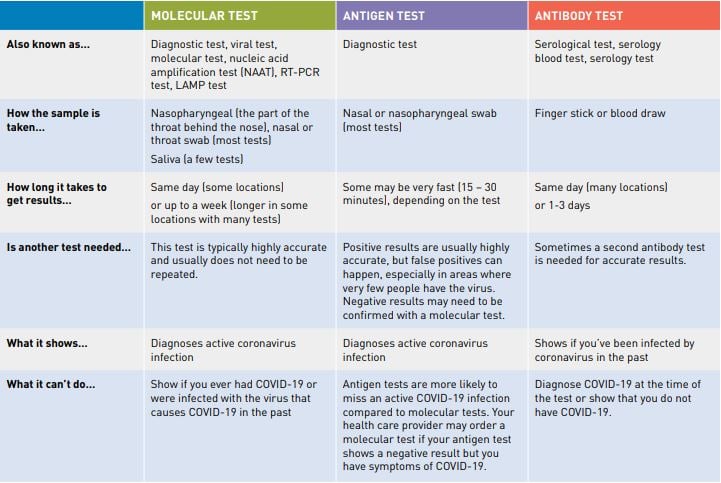There are two main types of COVID-19 tests:
- a viral test, which determines a current infection and
- an antibody test, which determines a prior infection.
COVID-19 Viral Testing: Viral tests check samples from the respiratory system (taken by swabbing the nose or mouth) to determine if the SARS-CoV-2 virus is present. Two types of diagnostic tests are used to determine if a patient has an active infection: Molecular and Antigen. Molecular tests look for genetic material created by the virus, while the antigen tests look for specific proteins created by the virus.1 Antigen tests usually provide faster results but have a higher probability of missing an active infection, according to the FDA. A Harvard Medical School study found that the false-negative rate of an antigen test is as high as 50%, while the false-negative rate for a molecular test ranges from 2% to 37%. A false negative means the test determined that a person was not infected, when in fact they were. The false-positive rate is near zero for both tests.2 As a point of comparison, the rapid influenza test which is used to test for seasonal influenza, has a false-negative rate of 50%-70%, which means it fails to identify the presence of influenza at least half of the time. Like the COVID-19 test, the false-positive rates for common influenza testing are very low.3
COVID-19 Antibody Testing: The COVID-19 antibody (serology) tests determine if a person has recovered from a COVID-19 infection. It takes an infected person 1-3 weeks to begin producing antibodies, so the test will neither identify an active COVID-19 infection nor detect a very recent infection. The blood test screens for antibody proteins that would have been developed by the patient to fight off COVID-19 and provide protection against re-infection for a still unknown period of time.1 The Harvard Medical School study determined the results could be skewed if the test is taken too soon after an infection. The current estimate of false negatives for COVID-19 serology tests is estimated to be around 20%.2
The FDA has compiled a comparison chart providing an overview of COVID-19 tests:

1. https://www.fda.gov/media/140161/download
2. https://www.health.harvard.edu/blog/which-test-is-best-for-covid-19-2020081020734
3. https://epmonthly.com/article/accurate-rapid-flu-tests/
COMMENTS